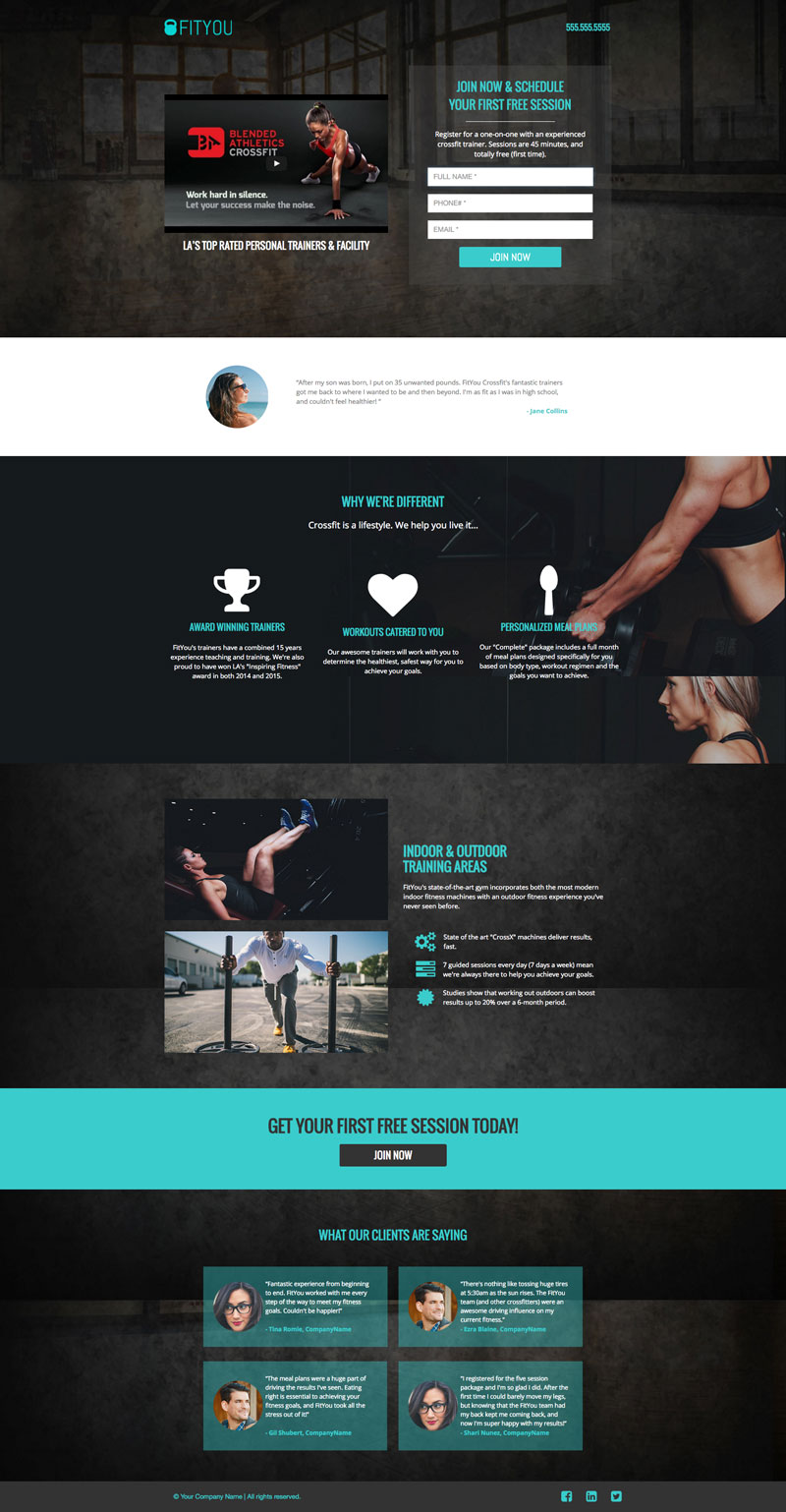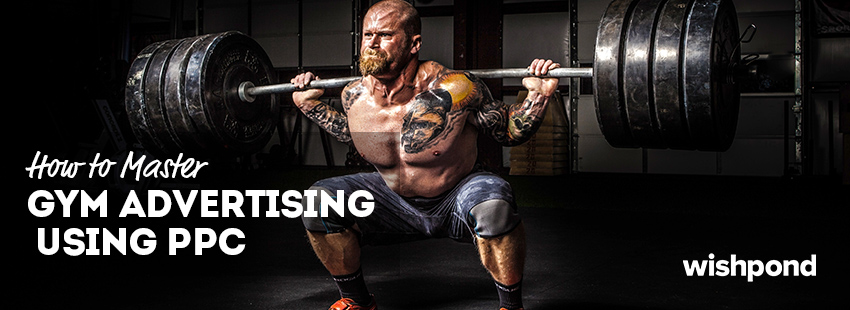Marketing your gym using PPC advertising is one of the fastest and easiest ways to generate more leads and customers online.
If you’re a gym owner, on the marketing team at a gym, or are thinking of soon entering the fitness industry, this guide will walk you through the three steps necessary to set up, optimize, and run a successful PPC advertising campaign using Google AdWords.
Even if you have no experience with online marketing, my goal is to have you generating leads like a pro by the end of this post.
Follow along, grab some water, and let’s pump it up!
Gym Advertising Step 1: Pick Your Keywords
The first step to setting up a PPC advertising campaign for your gym is to select some keywords that you want to target for search.
Keywords are the phrases that people that will type into Google that will trigger your ads. Here’s an example of a keyword set around the phrase “Gym Vancouver”

Especially if your gym is situated in a single location or one geographic region, it’s important to include a location name in your keyword set. This way you won’t be wasting ad dollars on clicks from people who aren’t potential customers.
If you need some inspiration to get you started, check out the Google Keyword Planner which allows you to search related words and phrases before creating your first keyword set.
Type in the phrase you’re thinking about targeting and click “Get Ideas”. Below you’ll have the option to filter by either ad group ideas (listed above) or keyword ideas (a general list of keywords related to the search term you entered).

Important things to notice when determining which keywords to pick are the keywords themselves, the average monthly searches, amount of competition, and the suggested bid price.
The sweet spot is to find keywords that you deem to have a high purchase intent, i.e. “buy gym membership vancouver” but also have a high monthly search volume, low competition and a low suggested bid.
Obviously finding that exact type of keyword opportunity is almost impossible, since high intent purchase intent keywords are usually highly sought after However, it is possible to find a good balance of competition, purchase intent, and overall bid price.
Try and come up with about 10-15 keyword phrases for your first ad set. Also try and keep them as focused as possible. If you have other aspects of your business (i.e. crossfit and a cycling studio), then save those search terms for another ad group. Google AdWord campaigns do best when they’re as specific as possibl, so try avoiding unsimilar keywords and topics at all costs.
You might be wondering what that “suggested bid” column was referring to inside of the keyword planner. In short that’s the minimum amount that you’ll need to bid to rank for that specific search term. That being said, bidding higher doesn’t necessarily guarantee you the top spot in search.
There’s a number of elements that go into determining where an ad will rank in the paid search queries. Google’s Chief Economist does a great job of describing how this system works:
To get a more indepth look at how to pick keywords and what match types to select, check out my article Getting to the Top of Google: A Recipe to Google AdWords.
Gym Advertising Step 2: Create Your Ads
Once you’ve got some keywords selected, it’s time to set up some ads. The ads you create will appear under a user’s search results when they enter your targeted keywords, or a phrase that matches with your targeted keywords.
Take a look at some example ads here:

Since the actual process of creating an ad is very well documented, rather than giving you a rundown of how to make a good ad, I’ll just give you some tips on how to help make your ad stand out from the crowd:
Tip #1: Make your benefits clear
Aside from your friends and maybe some of your loyal customers, no one really cares that your gym has been “in operation for 10 years.” Try and focus on conveying value in your ads. Examples of this might include:
- Free 7 day trials
- Open 24 hours
- No obligation memberships
- Free fitness assessments
- Swimming pools / olympic weight training facilities
Tip #2: Add a call to action
When creating your ads, consider what it is you’re trying to get your audience to do. Do you want them to sign up for a free trial? Are you trying to book more fitness assessments?
Whatever your trying to do, urge your audience to take action by including a clear call-to-action within your ad itself. Take a look at this ad, where they clearly state a call to action as their ad description.

By making it clear what you what you want your users to do, you can increase the likelihood that they’ll take action.
Tip #3: Use Call Extensions
Call extensions are a great way to incentivize users to click your ads more often. This is due to the fact that ad extensions add more options for users to click and can help provide more information about the products or services that you provide.
Here’s an example of ad extensions in action from a gym in New York:

By using ad extensions you can help hone in on the most important areas of your site to prospective customers. Examples of ad extensions can include:
- Website and product pages
- Reviews
- Hours of operation
- Click to call
- Ratings
Note that when a user clicks on one of your ad extensions, it still counts as a click on your AdWords account. That’s why it’s important to ensure that the pages that you link are optimized for conversion to ensure you’re not wasting your hard earned ad dollars. Which brings us to our last step…
Top Savings Tip: Enable call to click call extensions for mobile only.
Gym Advertising Step 3: Build a Landing Page
The last and most important step to setting up an effective PPC campaign is to ensure that the traffic you’re driving is arriving at a well optimized landing page.
Spending the time to research keywords, create ads, and drive traffic is literally useless without a compelling landing page for your users to landing on.
And the easiest way to create to create a high converting landing page is to start with a high converting template.
Take a look at one of the editable fitness templates available through Wishpond:

By clicking on elements of the page you’d like to edit such as text and images, you can quickly and easily replace the content of the page to promote your business.
No matter how you decide to create your landing page though, there’s a couple principles that are consistent across the board which can help you get the most out of your PPC traffic:
Tip #1: Match Your Landing Page With Your Ad Text”
One of the biggest mistakes beginners make when creating landing pages is not matching their landing page content to their ad content. Failing to do so results in a bad user experience and an unrefined campaign experience.
To fix this, try including your ad headline into your landing page headline. Chances are if someone clicked on an ad promising a “free 7 day trial”, then they want to see more information about that on the subsequent landing page.
Tip #2: Keep Your CTA’s Action Oriented
By default a lot of landing page builders and landing page templates might have the CTA set as “Submit”. This is one of the worst CTA’s to choose. Rather than leaving your CTA set to “Submit”, change it so say something that describes the action that they’re taking such as “Get Started” or “Send Me More Information”.
One trick to finding a good CTA is to simply state what the user is trying to accomplish. An example of this would be “Start My Free Trial”, or “Get My 7 Day Pass”.
There’s literally dozens and dozens of tips and tricks that can be implemented to create a high converting landing page. If you’re interested in learning more, check out our article 25 Tips to Optimize Your Landing Page for Conversion. To see a few examples, check out 17 Landing Page Examples Reviewed with A/B Testing Ideas
Generally speaking though, starting with a good foundational landing page base and ensuring that you meet some basic best practices, like keeping your landing page and ad sets consistent, and orienting your CTA towards action should take you 90% of the way.
Wrapping up
As you become more acquainted with AdWords and more comfortable with landing pages you might find yourself looking for more advanced tools like A/B testing and marketing automation.
But before we can start optimizing and automating, we need to first get that initial stream of leads coming in. Once you have all three components of your ad funnel in place (keywords, ads, and landing pages), it’s time to activate your AdWords campaign and watch the leads roll in.
So what are you waiting for?
Related Readings
- 10 Google AdWords Mistakes You Need to Avoid
- Google AdWords: 25 Glossery Terms You Need to Know
- 10 Questions: How to Plan a Successful Google AdWords Campaign
- 21 Ways: How to Create Landing Page / Google AdWords Combos that Convert
How to Drive Traffic to your Website

